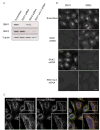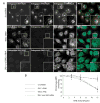Sorting nexin-2 is associated with tubular elements of the early endosome, but is not essential for retromer-mediated endosome-to-TGN transport
- PMID: 16179610
- PMCID: PMC1904489
- DOI: 10.1242/jcs.02568
Sorting nexin-2 is associated with tubular elements of the early endosome, but is not essential for retromer-mediated endosome-to-TGN transport
Abstract
Sorting nexins are a large family of phox-homology-domain-containing proteins that have been implicated in the control of endosomal sorting. Sorting nexin-1 is a component of the mammalian retromer complex that regulates retrieval of the cation-independent mannose 6-phosphate receptor from endosomes to the trans-Golgi network. In yeast, retromer is composed of Vps5p (the orthologue of sorting nexin-1), Vps17p (a related sorting nexin) and a cargo selective subcomplex composed of Vps26p, Vps29p and Vps35p. With the exception of Vps17p, mammalian orthologues of all yeast retromer components have been identified. For Vps17p, one potential mammalian orthologue is sorting nexin-2. Here we show that, like sorting nexin-1, sorting nexin-2 binds phosphatidylinositol 3-monophosphate and phosphatidylinositol 3,5-bisphosphate, and possesses a Bin/Amphiphysin/Rvs domain that can sense membrane curvature. However, in contrast to sorting nexin-1, sorting nexin-2 could not induce membrane tubulation in vitro or in vivo. Functionally, we show that endogenous sorting nexin-1 and sorting nexin-2 co-localise on high curvature tubular elements of the 3-phosphoinositide-enriched early endosome, and that suppression of sorting nexin-2 does not perturb the degradative sorting of receptors for epidermal growth factor or transferrin, nor the steady-state distribution of the cation-independent mannose 6-phosphate receptor. However, suppression of sorting nexin-2 results in a subtle alteration in the kinetics of cation-independent mannose 6-phosphate receptor retrieval. These data suggest that although sorting nexin-2 may be a component of the retromer complex, its presence is not essential for the regulation of endosome-to-trans Golgi network retrieval of the cation-independent mannose 6-phosphate receptor.
Figures









Similar articles
-
The mammalian phosphatidylinositol 3-phosphate 5-kinase (PIKfyve) regulates endosome-to-TGN retrograde transport.J Cell Sci. 2006 Oct 1;119(Pt 19):3944-57. doi: 10.1242/jcs.03153. Epub 2006 Sep 5. J Cell Sci. 2006. PMID: 16954148 Free PMC article.
-
Sorting nexin-1 mediates tubular endosome-to-TGN transport through coincidence sensing of high- curvature membranes and 3-phosphoinositides.Curr Biol. 2004 Oct 26;14(20):1791-800. doi: 10.1016/j.cub.2004.09.077. Curr Biol. 2004. PMID: 15498486
-
The retromer component sorting nexin-1 is required for efficient retrograde transport of Shiga toxin from early endosome to the trans Golgi network.J Cell Sci. 2007 Jun 15;120(Pt 12):2010-21. doi: 10.1242/jcs.003111. J Cell Sci. 2007. PMID: 17550970
-
The Black Book of Psychotropic Dosing and Monitoring.Psychopharmacol Bull. 2024 Jul 8;54(3):8-59. Psychopharmacol Bull. 2024. PMID: 38993656 Free PMC article. Review.
-
Home treatment for mental health problems: a systematic review.Health Technol Assess. 2001;5(15):1-139. doi: 10.3310/hta5150. Health Technol Assess. 2001. PMID: 11532236
Cited by
-
PtdIns(4)P regulates retromer-motor interaction to facilitate dynein-cargo dissociation at the trans-Golgi network.Nat Cell Biol. 2013 Apr;15(4):417-29. doi: 10.1038/ncb2710. Epub 2013 Mar 24. Nat Cell Biol. 2013. PMID: 23524952
-
WDR91 specifies the endosomal retrieval subdomain for retromer-dependent recycling.J Cell Biol. 2022 Dec 5;221(12):e202203013. doi: 10.1083/jcb.202203013. Epub 2022 Oct 3. J Cell Biol. 2022. PMID: 36190447 Free PMC article.
-
Phosphoinositide 3-kinase regulates the role of retromer in transcytosis of the polymeric immunoglobulin receptor.Exp Cell Res. 2007 Feb 15;313(4):707-18. doi: 10.1016/j.yexcr.2006.11.010. Epub 2006 Nov 23. Exp Cell Res. 2007. PMID: 17184770 Free PMC article.
-
A syntaxin 10-SNARE complex distinguishes two distinct transport routes from endosomes to the trans-Golgi in human cells.J Cell Biol. 2008 Jan 14;180(1):159-72. doi: 10.1083/jcb.200707136. J Cell Biol. 2008. PMID: 18195106 Free PMC article.
-
SNX4 in complex with clathrin and dynein: implications for endosome movement.PLoS One. 2009 Jun 16;4(6):e5935. doi: 10.1371/journal.pone.0005935. PLoS One. 2009. PMID: 19529763 Free PMC article.
References
-
- Barr VA, Phillips SA, Taylor SI, Haft CR. Overexpression of a novel sorting nexin, SNX15, affects endosome morphology and protein trafficking. Traffic. 2000;1:904–916. - PubMed
-
- Burda P, Padilla SM, Sarkar S, Emr SD. Retromer function in endosome-to-Golgi retrograde transport, is regulated by the yeast Vps34 PtdIns 3-kinase. J Cell Sci. 2002;115:3889–3900. - PubMed
-
- Carlton JG, Bujny MV, Peter BJ, Oorschot VMJ, Rutherford A, Mellor H, Klumperman J, McMahon HT, Cullen PJ. Sorting nexin-1 mediates tubular endosome-to-TGN transport through co-incidence sensing of high curvature membranes and 3-phosphoinositides. Curr Biol. 2004;14:1791–1800. - PubMed
-
- Carlton JG, Bujny MV, Rutherford A, Cullen PJ. Sorting nexins – Unifying trends and new perspectives. Traffic. 2005;6:1–8. - PubMed
Publication types
MeSH terms
Substances
Grants and funding
LinkOut - more resources
Full Text Sources
Molecular Biology Databases
Miscellaneous

